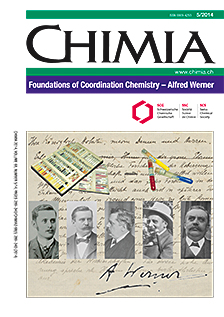Alfred Werner's Chemistry of Dinuclear Complexes – A Test Case of Werner's Intuition
DOI:
https://doi.org/10.2533/chimia.2014.299Keywords:
Ammine ligands, Bridging ligands, Cobalt, Dinuclear complexes, Werner, alfred, Werner collection of original samples, University of zurichAbstract
The re-investigation of four original tris-bridged dinuclear dicobalt complexes from the Werner collection of the University of Zurich by X-ray diffraction studies is described. The complex [Co2(NH3)6(?-NH2) (?-OH)(?-O2)](NO3)3 was studied recently. As the most interesting feature it was found to contain a ?-superoxo bridge, recognized by Alfred Werner and his coworker as an asymmetric peroxo bridge. The newly established ?-mono- and diacetato structures from crystals of the Werner collection, [Co2(NH3)6(?-OH)2(?-O2CMe)](NO3)3·H2O and [Co2(NH3)6(?-OH)(?-O2CMe)2](NO3)3·H2O, were assigned by Alfred Werner and his co-workers as mono- or di-bridged systems with the water functioning as ?1-aqua ligands and not, as revealed by the X-ray diffraction studies, as solvate molecules. Similarly the exact nature of the ?(N, O) nitrito bridge in the structure of the [Co2(NH3)6(?-OH)2(?-O2N)](NO3)3·H2O complex from the Werner collection was left open in Werner's and his coworker's description. Only the accuracy of the X-ray diffraction study could ascertain any earlier 'good guess'. The assignment of the bridges of bridged dinuclear structures at Werner's time are well conceived considering the lack of appropriate analytical tools. The structural assignments of Alfred Werner for the discussed dinuclear complexes are therefore considered to deviate only marginally from the real structures. They are testimonies of Alfred Werner's predictive abilities in coordination chemistry supported by his prepared mind, his great abilities of intuition and conceptual thinking.Downloads
Published
2014-05-28
Issue
Section
Scientific Articles
License
Copyright (c) 2014 Swiss Chemical Society

This work is licensed under a Creative Commons Attribution-NonCommercial 4.0 International License.
How to Cite
[1]
Chimia 2014, 68, 299, DOI: 10.2533/chimia.2014.299.







